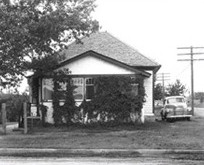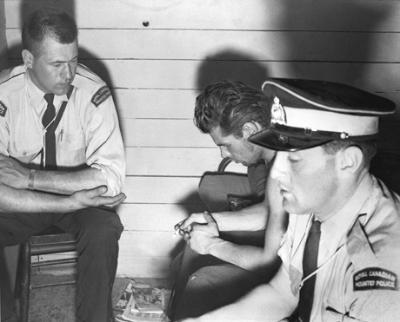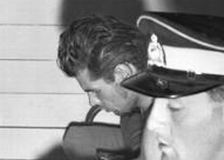Overview
In 1959, police discovered Raymond and Daisy May Cook and their five children shot and bludgeoned to death in the garage of their Stettler home, marking the most gruesome mass murder in the province's history. Evidence led police to the Cook's eldest son, Robert Raymond, who had been released from prison only days before the crime.
It took 18 months and two trials for Cook to be convicted of the murder of his father, stepmother and five siblings, for which he was sentenced to death. Shortly after the sentence was handed down, Cook escaped custody, but was found several days later, hiding in a straw stack.
At midnight, on November 14, 1960, he was led from his cell in Fort Saskatchewan, Alberta, to the execution chamber. He was pronounced dead at 00:18, and would be the last person to be hanged in the province.
The case has been the subject of a scholarly review, The Work of Justice by Jack Pecover, as well as a 2000 play, The End of the Rope by Aaron Coates, which was funded by Young Canada Works and written using archival documents from the Legal Archives Society of Alberta. The play was performed in the courtroom where the original trial had taken place, and one performance was attended by then-attorney David P. McNaughton, now a provincial judge.
Further reading
-
Jack Pecover (1996). The Work of Justice: The Trials of Robert Raymond Cook : the Story of the Last Man Hanged in Alberta. Wolf Willow Press. ISBN 1550564234.
Wikipedia.org
Robert Raymond Cook
AlbertaSource.ca
Recognized by his mischievous smile and short stature, many remember Robert Raymond Cook as a kind and popular individual. He had a natural propensity for mechanics at a young age, learning to drive a trailer truck before the age of 10. This attraction to vehicles, namely those belonging to others, landed Cook in jail on numerous occasions.
Released from prison just days before the murder of his family took place, Robert Raymond Cook had a complex history of delinquency. When his mother died, a deeply affected nine-year-old Cook became rebellious. At 12, when his father married his grade school teacher, Daisy Mae Gaspar, and moved the family from Hanna to Stettler, Cook began to act out, dabbling in illegal activities, a practice that would ultimately bring him to the gallows at the Fort Saskatchewan Gaol.
The most problematic and significant character trait Cook displayed was his disregard for the truth and, in many cases, the law. While it was true that Cook had a lengthy history of behavioural problems leading him to correctional facilities, it was not this information that was used to convict and hang him. Surrounding the murder of his family was a web of lies that could never quite be explained, at least not beyond the possibility of doubt. First of all, Cook was found using his father's identity to sell and purchase a car that could not be proven to belong to him. Secondly, Cook's alibi was difficult to prove. Both factors led to the demise of his defence.
Despite the fear he inspired in many Albertans, most people who came into contact with Cook described him as a calm and gentle character, who many thought incapable of the crime he had been executed for.
The Last Man to Hang in Alberta
The 1959 discovery of Raymond and Daisy May Cook and their five children, shot and bludgeoned to death in the garage of their Stettler home, sent shockwaves throughout the whole of Alberta and prompted the dramatic investigation of one the most gruesome murder cases in the province’s history.
Evidence pointed toward the Cook’s eldest son, Robert Raymond, released from prison just days before the crime had taken place. Cook was apprehended on suspicion and admitted to the Ponoka Mental Institution for psychiatric evaluation. He promptly managed to escape, but was recaptured four days later following a manhunt of a proportion Alberta had not seen previously or since. A year and a half after the crime, following two trials, culminating in two convictions, Robert Raymond Cook was sentenced to death.
At midnight on 14 November, 1960, Cook was led from his Fort Saskatchewan, Alberta cell. Just minutes later he was hanged, and by 12:18 am, he was pronounced dead, the last person to be executed in Alberta.
One of the grisliest moments in Alberta history, the Cook case harkens back to a time when capital punishment was an acceptable part of our culture.
The last man to hang in Alberta
By Greg Gazin
SmokyLake.com
"Gentlemen of the jury, have you arrived at verdict?" the clerk intoned. There was absolute silence in the courtroom. The trial had lasted six days yet it took a six-person jury only 32 minutes to determine this man's fate. "We have," said the foreman. "Guilty."
Robert Raymond Cook, believed to have been around 22 years old, was found guilty of murdering his family and sentenced to death during a trial held in the summer of 1959. Just before midnight on November 14 of that year he was led to the gallows in Fort Saskatchewan, Alberta, still protesting his innocence. Cook was executed and pronounced dead at 12:18 AM, November 15. He was the last man to hang in Alberta.
Cook had been accused of murdering his father, Raymond Cook, stepmother, Daisy May Cook, and his five siblings. They were shot and bludgeoned to death in their Stettler home on June 25th, 1959. Robert was the eldest child.
It took two trials to reach the final verdict. The first, held in Red Deer a year earlier, was presided over by Justice Peter Greschuk. While he was also found guilty at this trial, the verdict was appealed and a new trial was ordered by the Appellate division because Justice Greschuk refused the testimony of one of the witnesses.
Bringing the story to life
The details of the second trial have been re-enacted in a 30-minute radio docudrama, or podcast, that can be found at the Great Alberta Law Cases website at the Alberta On-Line Encyclopedia - www.albertasource.ca. The Heritage Community Foundation, which developed and maintains the Alberta Online Encyclopedia, developed the website with funding support from the Alberta Law Foundation. Foundation staff researched each case and provided a context for the docudramas produced by CKUA. There are 20 cases on site and they are enriched by the dramatic narration, music, sound effects, dialogue and back-story developed by CKUA that give listeners a multi-sensory, you-are-there, experience.
The docudrama begins with events that occurred on July 11, 1959: with the sound of aircraft hovering over farmland near Stettler, over 100 RCMP officers and two tracking dogs searched for suspected mass murderer Robert Raymond Cook, who had escaped a mental institute in Ponoka. It wasn't long, however, before Cook was captured at a pig farm near Bashaw, 80 km from Edmonton.
The second trial, this time held in Edmonton, was presided over by Justice Harold Riley. Cook took the stand to recount his every movement in the days just prior to the murders in an attempt to establish his alibi.
Cook was described at the time as a colourful delinquent, with a self-deprecating sense of humour, and a long list of criminal activities, but nothing suggested he was a violent man.
"I went to the Commercial Hotel in Edmonton and checked in," he said during his testimony. "I got a car - stole it from a lot on the south side out the Calgary Trail." He then calmly detailed how he drove to Bowden, near Red Deer, to recover some money he had hidden there in 1957. He then drove back to Edmonton and returned the car to the same lot from which he had taken it. He then continued, just walked around, "because I had been locked up for two years."
Later that evening, Cook caught up with his father as he got off work; they had a few beers and both returned home to Stettler.
Cook's lawyer, Frank Dunne, then asked Cook to describe his relationship with his family, which he replied was warm and friendly. He said he and his father, a mechanic, had discussed a partnership: his father supposedly wanted to open a garage in BC and, in exchange for $4,300, would sign over title of the family's 1958 station wagon to his son. Cook said he was going to use the station wagon as a down payment on a brand new Impala convertible he had his eye on.
Cook said that, as his father was handing over the paperwork for the station wagon, he asked him for his driver's license as well, because he had misplaced his. To facilitate the car purchase, he said, his father agreed, handing him his wallet.
Cook was named after his father so at a quick glance the documents in question could appear to belong to the son. Having his father's wallet in his possession would come back to haunt him.
Cook further told the court that his family intended to pack up that very night - June 25th - and go to BC, while he headed to Edmonton to buy the Impala. He arrived back in Edmonton just after midnight, met up with friends and had a few drinks. Later he met up with another friend, Sonny Wilson, and both promptly broke into a dry cleaners on Whyte Avenue.
Bodies unidentifiable
It was during the night of June 25th that someone entered the Cook family's farmhouse, 200 km from Edmonton, and shot and bludgeoned the family to death in their beds. The bodies were then dragged to a grease pit in the garage. The act was so savage that the bodies were almost unidentifiable.
On June 26, in Edmonton, Cook traded in the family station wagon for the Impala. The following Saturday the RCMP apprehended Cook with his father's papers in his possession and charged him with obtaining goods under false pretenses. As part of a routine check and to advise the father of his son's actions, the RCMP visited the Cook family home the next day and made the gruesome discovery.
Crown Counsel J.W Anderson cross-examined Cook and established that Cook lied to the car salesman. He questioned him as to why he would jeopardize his new freedom to commit a petty crime (the dry cleaners); why his father would have no qualms about accepting stolen money; and why the entire family was going to pack that night, take public transit to BC but yet give him the family's car.
Cook could not come up with any plausible answers.
Anderson continued to hammer away at him, insisting that it would be hard to look at garages to buy without a vehicle and asking how his father could travel without a wallet and ID. He also pointed out that Cook's father had promised a neighbour that he would help move furniture the next day.
The defense insisted that it was all circumstantial. There were only two sets of fingerprints in the house; those of the mother and one of the children, yet seven people lived there. Furthermore, the RCMP estimated the murders occurred at midnight, yet Cook was in Edmonton, 200 km away, only 90 minutes later. Dunne also pointed out that it took four men two hours to remove the grisly remains from the grease-pits: How was it possible, he asked, for one person to move all of those bodies, clean the premises and drive all the way to Edmonton in that short a time? Furthermore, he asked, is it probable for one person to kill seven people and not have even one child escape?
Justice Riley reminded the jury that the burden of proof lay with the Crown. He added that circumstantial evidence, in order to be conclusive, must complete a chain of facts or links that leads to beyond reasonable doubt. If a link is missing, he said, then, the evidence is not valuable.
The outcome left many questions unanswered: the actual time of the murder; the fact that the money was never found; and that one of the murder weapons, a shotgun, didn't belong to anyone in the household.
Historian Alan Hustak noted at the time that the case was so highly publicized that it would have been difficult to have a fair trial. Seven years later, Parliament amended the criminal code to allow a maximum penalty of life imprisonment except for a case of murder of police officers or prison guards. In 1976, the death penalty was abolished in Canada.
Cook's poem

LegalArchivesSociety.ab.ca

The Cook family home in Stettler where the bodies were found.

Robert Raymond Cook, centre, is
guarded by RCMP officers after his arrest for the
killing of his father, stepmother and five siblings in
1959.
(Photo from Provincial Archives of Alberta)

